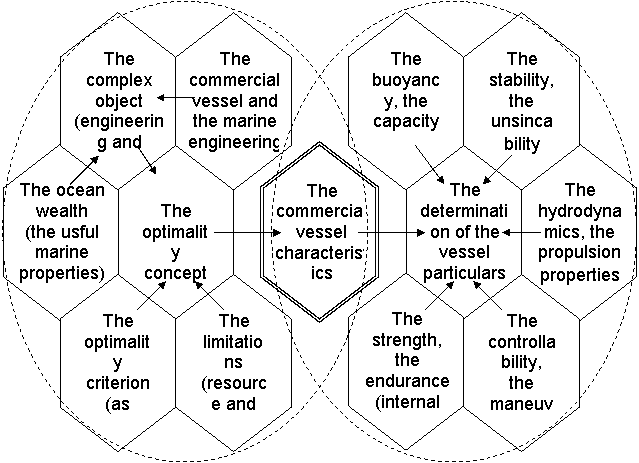
 |
|
||||||||
25. Guidelines for determination of economically efficient vessel characteristics and particulars for the commercial order for construction or purchase at the pre–owned market
It should be explained, that the methods of characteristics optimization by economic criteria are applicable for vessels (or other real assets as a part of marine company’s property complex) to an extent to which the object of optimization can be evaluated as the company’s property complex.
Usually it can be referred to the marine commercial vessel if the difference of the vessel’s properties from the property complex are taken into account by the adjustment, for example, in addition to commercial vessel estimation to determine the working assets and to consider them in the general algorithm and if the number of variable of the vessel’s characteristics optimized by the economic criterion is not too great.
When working out the model in details and increasing the number of varied characteristics, it becomes clear that many of characteristics are in functional interrelation, other, than the conformity of the optimality by the economic criterion.
At preliminary stages of the investment planning after the estimation of the vessel main characteristics which are optimum from the economic point of view and correspond to the best values of the criterion (the left half of the scheme, fig. 25), as a first approximation it is required to determine a number of dependent characteristics and particulars to generate technical requirements for the vessel order for constructing or purchase.

Fig. 25. The economical optimality of the commercial vessel project characteristics
and particulars in the naval architecture and marine engineering systematic concept
Dependent vessel characteristics, as well as particulars can be determined on the basis of naval architecture calculations (the right half of the scheme, fig. 25) on the basis of the analysis of physical properties of the commercial vessel’s interaction with the marine environment (seaworthy properties), and also taking account of the internal properties of the commercial vessel design that is usually made after the investments are received at stages of the structural and technological design and it is not quite acceptable for the process of working out the investment project.
In other words, the left part of the scheme on fig. 25 shows the determination of vessel characteristics by the economic criterion and this optimization method is called «an external subject», that at the same time the right party of the scheme shows – the determination of the commercial vessel particulars from the physical point of view that is «an internal subject».
Since the external subject (the left part of the scheme) usually is solved by the investor – the shipping company which in the national relation gravitates to the ocean resources, and an internal subject (the right part of the scheme) is solved at the shipyard which most probably is located in the global industrial centre of East Asia, then, the condition of vessel characteristics optimality by the economic criterion which is structurally shown on the scheme, has an international sense.
At preliminary design stages to determine the dependent characteristics and particulars when formulating the technical requirements for the vessel of the commercial order it is possible to use statistical dependences which approximately reflect developed parities between characteristics and particulars of an efficient, seaworthy and reliable vessel, safe in operation, strong and durable.
According to system principles the independent characteristics of the vessel defined on the basis of optimization by the economic criterion, usually are chosen from the get out of number of the following ones: displacement D, displacement empty DP, cargo capacity PG and deadweight DW (considering, that from the listed four vessel characteristics usually two or three are dependent according to a certain degree of subject generalization), volume of vessel cargo holds W, total register tonnage GRT and net register tonnage NRT, power of main engine Ne, operational speed υS, etc.
Usually at the phase of commercial vessel project optimization by the economic criterion from one to three or four characteristics vary, and depending on them other vessel characteristics and particulars are determined on the basis of design shipbuilding calculations or under empirical (statistical) formulas, and also on the basis of data of analogues use.
Besides the independent characteristics determined by optimization by the economic criteria, in order to work out technical requirements for the vessel order it is necessary to determine also dependent characteristics and particulars such as: the commercial vessel dimensions, including waterline length LW, length over all L (or LOA); breadth B, draught TW at cargo waterline and depth H to the main deck (that is decks of impenetrable transverse bulkheads), and also, the factor of the general volume displacement δ– the ratio of commercial vessel volume displacement to multiplication of waterline length, breadth and draught at cargo waterline.
The general recommendations concerning the characteristics and particulars in the order for vessels of widespread classes depending on the main characteristics which are preliminary determined by optimization by the economic criteria with the account the financial constrains of the investor or functional limitations are presented below.
Besides, formulas which are presented in Chapter 25 for commercial vessel of corresponding class at a stage of data processing can be applied to check the compatibility of commercial vessel data or to additional determination of absent data, and also for the educational purposes when doing practical exercises – for vessel characteristics determination in learning tasks.
The results of the given Chapter were studied with the participation of M.B. Bezuglova and M.V. Kovalenko under the author’s guidance.
Test questions
1. Applicability of methods of optimization by the economic criterion for determining the characteristics of the vessel (or other marine company asset).
2. Dependent characteristics and particulars of vessel.
3. Formation of technical requirements for the commercial order for vessel (or other marine company asset).
25.1. Correlation between of cargo vessel characteristics and particulars
The dependences between characteristics of marine cargo vessels (for example of a universal dry–cargo motor vessel and a commercial vessel for transportation of crude cargoes), between particulars, and also between characteristics, on the one hand, and particulars, on the other hand, are formalized on the basis of statistical generalizations and reflect developed parities between characteristics and particulars of an efficient, seaworthy and reliable vessel, safe in operation, strong and durable to an extent in which these properties are inherent in the used data of analogues.DW = 0.409 × D1.063, tonne; |
(25.1) |
PG = 0.232× D1,051, tonne; |
(25.2) |
ÐFL = 0.0015× D1.368, tonne. |
(25.3) |
DW = 0.477 × D1.043, tonne; |
(25.4) |
PG = 0.874 × D0.919, tonne; |
(25.5) |
ÐFL = 0.0015 × D1.338, tonne; |
(25.6) |
W = 0.493 × D1.05, cubic meters. |
(25.7) |
D = 0.583× LW1.945, tonne; |
(25.8) |
DP = 1.333 × LW1.501, tonne; |
(25.9) |
DW = 0.159 × LW2.149, tonne; |
(25.10) |
PG = 0.387 × LW1.81, tonne; |
(25.11) |
W = 0.031 × LW2.542, cubic meters; |
(25.12) |
GRT = 0.192 × LW2.058; |
(25.13) |
NRT = 0.0505 × LW2.152. |
(25.14) |
D = 0.181 × LW2.255, tonne; |
(25.15) |
DP = 0.11 × LW2.1, tonne; |
(25.16) |
DW = 0.087 × LW2.334, tonne; |
(25.17) |
PG = 0.322 ×LW1.946, tonne; |
(25.18) |
W = 0.076 × LW2.385, cubic meters; |
(25.19) |
GRT= 0.038 × LW2.445; |
(25.20) |
NRT = 0.023 × LW2.362. |
(25.21) |
LW / B = 2.814 × ln(LW) – 5.712; |
(25.22) |
B / TW = 0.0086 × LW + 2.535; |
(25.23) |
H / TW = 0.151 × LW 0.468; |
(25.24) |
LW / H = 8.812 × LW 0.16; |
(25.25) |
δ = 0.0016 × LW + 0.504. |
(25.26) |
LW / B = 2.013 × ln(LW) – 2.527; |
(25.27) |
B / TW = 0.469 – 0.0007 × LW; |
(25.28) |
H / TW = 0.59 × LW 0.174; |
(25.29) |
LW / H = 2.938 × LW 0.348; |
(25.30) |
δ= 0.0008 × LW + 0.689. |
(25.31) |
– For universal dry–cargo vessel Ne= 0.418 ×D0.957, kW; |
(25.32) |
– For crude cargoes tanker Ne= 0.591 × D0.909, kW. |
(25.33) |
– For the universal dry–cargo vessel υS = 5.795 × LW0.142, knots.; |
(25.34) |
– For crude cargoes tanker υS = 2.33 × LW0.344, knots. |
(25.35) |
– For the universal dry–cargo vessel Ne=υS2.5×D0.5/21.6 , kW; |
(25.36) |
– For crude cargoes tanker Ne=υS2.5×D0.5/21.9, kW. |
(25.37) |
Test questions
1. Parametrical properties of the commercial vessel dependent characteristics.
2. Estimation for the commercial order of the commercial vessel displacement by the equation of the balance of loading depending on deadweight.
25.2. Dependences between characteristics and particulars of fishing vessel
After the phase of determination of independent characteristics according to the concepts of the systematic approach by optimization methods by the economic criterion it is required to estimate other characteristics – dependent, and also design particulars of the marine steel fishing vessel for the commercial order since usually there is only one independent characteristic from among the main ones such as: vessel displacement D, cargo capacity PG and deadweight DW in case of economic optimization at early stages of fishing vessel designing – before obtaining the basic investments.0.37×D-1.37×D1/2-DW=0; |
(25.38) |
0.40×D-0.68×D2/3-DW=0; |
(25.39) |
0.21×D-1.09×D1/2-PG=0. |
(25.40) |
(0.37÷0.40)×D - α×1.37×D1/2 - (1-α)×0.68×D2/3 - DW = 0. |
(25.41) |
W/PG = 6.03×D-0.122cubic meter / tonne – specific tonnage; |
(25.42) |
GRT=0.385×D1.074; |
(25.43) |
NRT=0.127×D1.071; |
(25.44) |
W=0.42×D1.003 , cubic meters; |
(25.45) |
D=0.113×LW2.394, tonne; |
(25.46) |
DW=0.0228×LW2.515, tonne; |
(25.47) |
PG=0.0066×LW2.67, tonne; |
(25.48) |
W=0.0514×LW2.407 , cubic meters;; |
(25.49) |
GRT=0.035×LW2.60; |
(25.50) |
NRT=0.0126×LW2.569. |
(25.51) |
| – The relative length of a fishing vessel in dependence on waterline length LW/B=1.93 × ln(LW) - 2.93; |
(25.52) |
– The relative breadth of fishing vessel B/TW = 0.0039×LW + 2.38; |
(25.53) |
– The height of fishing vessel board H to the main deck H=0.40×LW 0.68, m ; |
(25.54) |
– The height of fishing vessel board HD to main deck HD=1.24×LW 0.50 , m; |
(25.55) |
– The relation of fishing vessel length LW to height H of the board to main deck LW/H=2.50×LW 0.32; |
(25.56) |
– The relation of fishing vessel length LW to height HD of the board LW/HD=0.81×LW 0.50; |
(25.57) |
– The relation of height H of the board to the fishing vessel main deck H/TW=0.92×LW 0.10; |
(25.58) |
– The relation of height HD of the board to fishing vessel upper deck to draught TW in cargo HD/TW=1.18×LW 0.09; |
(25.59) |
– The factor of the general volume displacement δ = 0.0016×LW + 0.504. |
(25.60) |
| – The power of fishing vessel’s main engine Ne=3.57×D0.81 , kW; | (25.61) |
– The total power of fishing vessel auxiliary engines Nu=3.98×D0.66 , kW; |
(25.62) |
– The formula of the «Admiralty factors» by the results of statistical data generalizations Ne=νS2.5×D1/2/15.5, kW. |
(25.63) |
q1=0.008×Ne0.946, tonne / day. |
(25.64) |
νS=3.17×LW0.346, knots. |
(25.65) |
Test questions
1. Independence of variable for optimization by the economic criterion and interrelation between the fishing vessel main characteristics: displacement, cargo capacity and deadweight.
2. Additional determination of fishing vessel dependent characteristics by the balance equation, the variants of fishing vessel balance equation.
3. General recommendations concerning determination of dependent characteristics of commercial vessels of various classes with accumulation and use of statistical data.
4. Estimation of characteristics and particulars for the control of the quality of construction from the part of investor.
5. Application of the values of dependent characteristics and the particulars of commercial vessel, determined statistically, for estimation of functional depreciation and purchase price concessions.
 |
 |
|||||